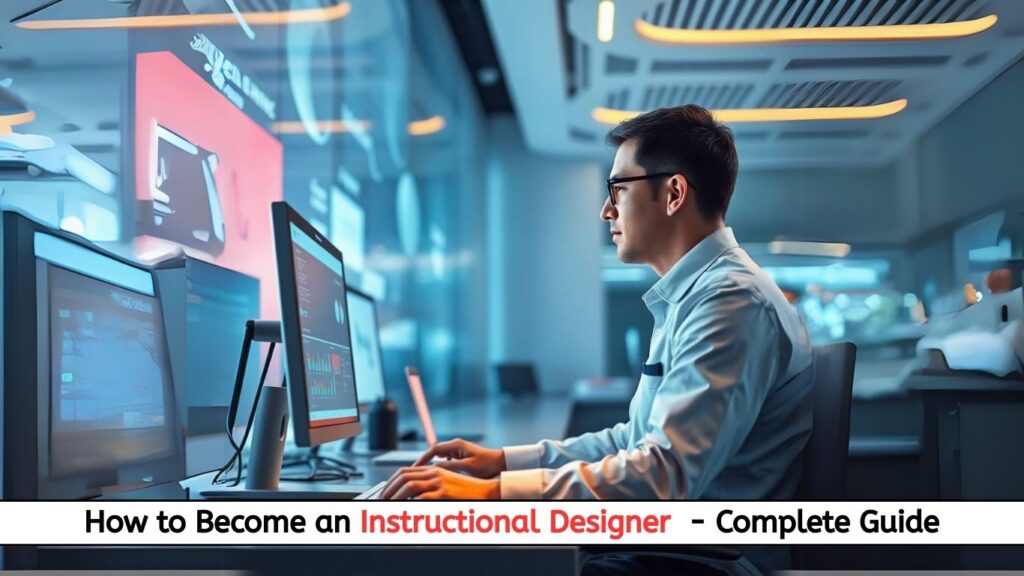
Introduction
Instructional Designers are the architects of effective learning experiences, creating engaging courses for schools, corporations, and online platforms. With the e-learning market projected to reach $1 trillion by 2030, this career offers high demand, creativity, and excellent pay.
This comprehensive guide covers:
✅ History of Instructional Design
✅ Salary Expectations (Corporate, Academic, Freelance)
✅ Key Roles & Responsibilities
✅ Must-Have Qualifications & Skills
✅ Step-by-Step Career Path
✅ Future Trends & Job Outlook
Let’s dive in!
1. The History of Instructional Design
World War II Era (1940s-1950s)
- The U.S. military needed fast, effective training for soldiers.
- Psychologists like Robert Gagné developed structured learning models.
The Birth of Modern ID (1960s-1980s)
- 1965: Gagné published “The Conditions of Learning”, outlining 9 Events of Instruction.
- 1970s: ADDIE Model (Analyze, Design, Develop, Implement, Evaluate) became the gold standard.
Digital Revolution (1990s-2010s)
- CD-ROMs and early LMS platforms (like Blackboard) emerged.
- 2000s: Rise of e-learning authoring tools (Articulate, Captivate).
Today’s Trends (2020s & Beyond)
- AI-powered learning, microlearning, and VR training dominate.
- Corporate L&D and online education drive demand for skilled designers.
2. Instructional Designer Salary Expectations
Salaries vary by experience, industry, and location:
| Experience Level | Average Salary (Annual) |
|---|---|
| Entry-Level (0-2 yrs) | $50,000 – $70,000 |
| Mid-Level (3-5 yrs) | $70,000 – $90,000 |
| Senior-Level (5+ yrs) | $90,000 – $120,000+ |
| Freelance/Consulting | $50 – $150 per hour |
Top-Paying Industries
✔ Corporate Training ($75K – $110K)
✔ Tech & Software Companies ($80K – $130K)
✔ Healthcare & Pharma ($70K – $100K)
✔ Higher Education ($60K – $90K)
Note: Certifications (e.g., ATD, CPTD) increase earning potential.
3. Roles & Responsibilities of an Instructional Designer
A. Needs Analysis & Research
- Identify learning gaps through surveys, interviews, and data.
- Define learning objectives (e.g., “Employees will master new software in 4 weeks”).
B. Course Design & Development
- Apply instructional models (ADDIE, SAM, Bloom’s Taxonomy).
- Create storyboards, scripts, and assessments.
C. Multimedia Content Creation
- Develop videos, animations, quizzes, and simulations.
- Use tools like Articulate 360, Adobe Captivate, and Vyond.
D. LMS & Technology Integration
- Upload courses to Learning Management Systems (Moodle, Cornerstone).
- Ensure SCORM/xAPI compliance for tracking.
E. Evaluation & Improvement
- Measure learner engagement & ROI.
- Optimize courses based on feedback.
4. Qualifications & Skills Required
A. Educational Background
- Bachelor’s degree in Instructional Design, Education, or Psychology (common).
- Master’s degree (preferred for senior roles).
B. Certifications
✔ ATD’s Certified Professional in Learning & Performance (CPLP)
✔ eLearning Guild’s Instructional Design Certificate
✔ Google’s UX Design Certificate (for interactive learning)
C. Technical Skills
✔ Authoring Tools: Articulate Storyline, Rise, Camtasia
✔ Graphic Design: Canva, Photoshop, Illustrator
✔ LMS Platforms: Moodle, TalentLMS, Docebo
D. Soft Skills
✔ Storytelling & Visual Communication
✔ Project Management (Agile, Trello, Asana)
✔ Analytical Thinking (Data-Driven Design)
5. How to Get Started as an Instructional Designer
Step 1: Learn the Fundamentals
- Take free courses:
- Coursera: “Instructional Design MasterTrack”
- LinkedIn Learning: “Become an Instructional Designer”
Step 2: Build a Portfolio
- Create 3-5 sample courses (e.g., “Sales Training,” “Software Tutorial”).
- Use free trials of Articulate or Captivate.
Step 3: Gain Experience
- Freelance: Join Upwork, Fiverr, or Toptal.
- Internships: Look for L&D departments or e-learning firms.
Step 4: Get Certified (Optional but Helpful)
- ATD’s Associate Professional in Talent Development (APTD)
- Certified Online Learning Facilitator (COLF)
Step 5: Apply for Jobs
- Job Titles to Target:
- E-Learning Developer
- Curriculum Designer
- Learning Experience Designer
6. Future of Instructional Design
Emerging Trends
🚀 AI & Chatbots – Personalized learning assistants.
🚀 Immersive Learning – VR/AR for realistic simulations.
🚀 Microlearning – Bite-sized, mobile-friendly lessons.
🚀 Data-Driven Design – Analytics to optimize courses.
Job Outlook
- 10% growth by 2030 (faster than average).
- High demand in corporate training, healthcare, and tech.
Final Thoughts: Is This Career Right for You?
Instructional Design is perfect if you:
✓ Love teaching + technology
✓ Enjoy creative problem-solving
✓ Want to work remotely or freelance
Pro Tip: Specialize in high-demand niches (compliance training, AI-powered learning).
Ready to Start?
📌 Comment below for free tool recommendations!
📌 Share this guide with future IDs!













Post Comment